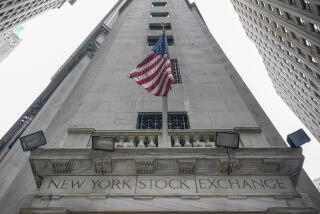Regulators Meet With Bankers to Ease Credit Fears
- Share via
WASHINGTON — The nation’s top financial regulators held an extraordinary meeting with bankers on Thursday to avert fears of a credit crunch and to encourage the bankers to continue making “prudent” loans.
The meeting between the regulators and the board of the American Bankers Assn. was scheduled several weeks ago at the regulators’ request “to dispel a lot of rumors” about the federal agencies’ examination of real estate loans in bank portfolios, said Lee Cross, a spokeswoman for Comptroller of the Currency Robert Clarke.
Joining Clarke in a show of unity before the bankers were Federal Reserve Board Chairman Alan Greenspan and Federal Deposit Insurance Corp. Chairman L. William Seidman.
“We are hearing stories of banks overreacting,” Cross said. “We’re not saying to banks, don’t make loans. We’re saying, make good loans.”
Many bank customers--notably small businesses, real estate developers and builders--have complained that they find it increasingly difficult to borrow money. They complain that bankers are exceedingly nervous about pressures from federal regulators, and have become wary of dealing with some of their oldest customers. The bankers, in turn, say the regulators cast a very critical eye on real estate loans.
The financial regulators’ mission Thursday was to tell the bankers to keep the money flowing in a judicious manner.
“They were carefully trying to give the message not to overreact to examination policies, and to continue to make prudent loans,” said Mary-Liz Meany, a spokeswoman for the American Bankers Assn. “They let us know they were listening to bankers’ concerns,” she said.
Despite the assurances, regulators are clearly worried about the real estate market, which has suffered sharp price declines in some regions.
Seidman, who is also chief of the federal thrift cleanup effort, said Thursday in a breakfast meeting with Times reporters and editors that even in California weak real estate markets will cripple many already-troubled savings and loans--forcing them into government hands and driving up the cost of the massive S&L; bailout.
Real estate prices in the San Francisco area have “topped out now, by every indication,” said Seidman. Government will be taking control of “a number of S&Ls; in the San Francisco area,” he predicted, without naming any individual institutions.
Federal regulators have seized 400 failing S&Ls; and could acquire several hundred more, depending on the health of real estate markets, Seidman said.
“It’s a moving target all the time, which is tied into the marketplace,” said the chairman of the Resolution Trust Corp., which administers the takeover of S&Ls; and the sale of assets from defunct institutions. Taxpayers will bear the burden as the government closes insolvent S&Ls; and pays off depositors, whose accounts are insured up to $100,000.
S&Ls; are big construction and real estate lenders. When sales of homes and rentals of office buildings lag, borrowers default on loans, and thrift institutions suffer financial difficulty.
The real estate depression in Texas and Oklahoma, under way for years, has spread to Arizona, and the Northeast is showing severe signs of weakness, Seidman said. “There is not a developer from here to Maine who doesn’t have a problem on one of his projects,” the RTC chairman said. “They’re all under stress.”
Seidman avoided making any flat predictions of widespread economic trouble for California. But he noted that people in Arizona and Massachusetts were saying several years ago that their economies were too diversified to suffer a Texas-type plunge in real estate values.
“The California economy has been very strong; real estate markets are very strong,” Seidman said. However, he said, in some areas of the state, there are “high new-construction levels, relatively low employment gains, and high new-vacancy rate gains.” This means the supply of office space is apparently outpacing the economic activity needed to fill those new buildings.
Seidman came under criticism recently after issuing a list of real estate market indicators showing that some California cities had the highest office vacancy rates outside the depressed markets of Texas, Oklahoma, Arizona and Colorado.
More to Read
Inside the business of entertainment
The Wide Shot brings you news, analysis and insights on everything from streaming wars to production — and what it all means for the future.
You may occasionally receive promotional content from the Los Angeles Times.










